Opinion
I Looked Through All 5,000 Images in Beeple’s $69 Million Magnum Opus. What I Found Isn’t So Pretty
'Everydays: The First 5,000 Days' is the third-most expensive work ever by a living artist. Not many people have actually looked at it.

'Everydays: The First 5,000 Days' is the third-most expensive work ever by a living artist. Not many people have actually looked at it.

Ben Davis

“We didn’t need a preview.” So said Twobadour, one of the players behind the purchase of the all-digital work by artist Beeple (aka Charleston-based digital artist Mike Winkelmann) at Christie’s last week, when asked if he had actually looked at the lot before his company paid $69 million for it.
Despite this stomach-turning auction price, Twobadour claimed that the investment was destined to appreciate in value into the future: “This is going to be a billion-dollar piece someday.”
I’ll take his word for it that he knows Beeple’s oeuvre so well that he didn’t need to review all the images contained in Everydays: The First 5,000 Days. But does the public know what’s in Beeple’s opus? That’s likely to determine the piece’s reputation in the medium and long term, as observers and a baffled public wrestle with what the Beeple phenomenon really means.
The work is, in effect, a large, square image file (21,069 by 21,069 pixels). It’s a digital mosaic composed of images that Beeple has released on the web, one a day, since May 1, 2007. This “Everydays” series is more or less the digital equivalent of a sketchbook, though what Beeple can whip up with 3D graphics gets more and more elaborate as we get closer to the present.
“By posting the results online I’m ‘less’ likely to throw down a big pile of ass-shit,” the artist explains of the impetus behind the daily creative exercise on his website, “even though most of the time I still do because I suck ass.” That tireless effort to throw down mostly ass-shit is now valued at about $14,000 per day.
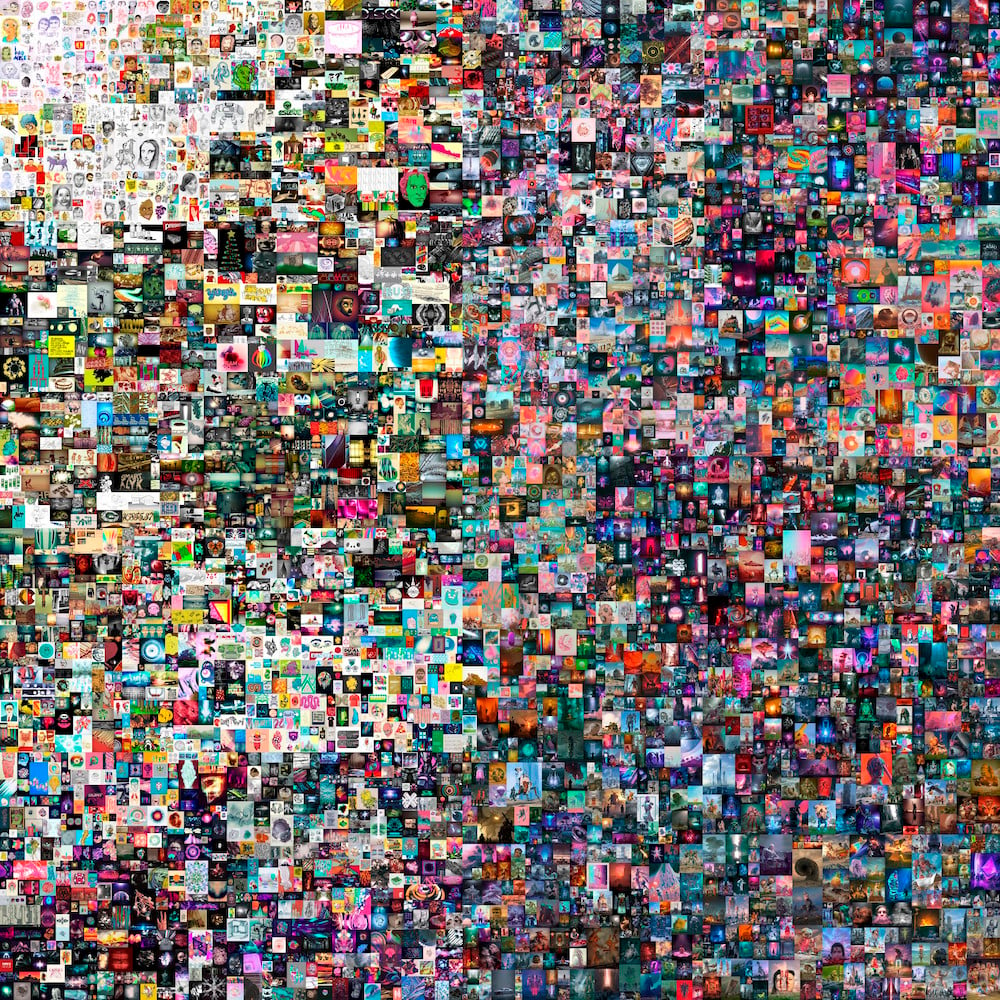
Beeple, Everydays – The First 5000 Days NFT, 21,069 pixels x 21,069 pixels (316,939,910 bytes). Image courtesy of the artist and Christie’s.
You can zoom in a bit to the tiled image of Everydays on the Christie’s site—but not that much. To really see the works and get a sense of Beeple’s vision, you have to go to his website. I went and clicked through all 13 years of work. Going through it all took about a day.
Here’s what I found. Essentially, there are four different Beeples at play in Everydays. None is likely to age well.
In reverse chronological order, the most recent, most well-known, and most successful Beeple is the digital satirist, making what amount to gross-out cartoons commenting on incipient tech dystopia and political outrages. The Christie’s preview of individual images from the work all hail from this era.
But it’s a surprisingly recent persona. Beeple’s only been working consistently in this mode for the last few years, and it’s very much a product of the climate of nonstop social media outrage that defined the Trump years.
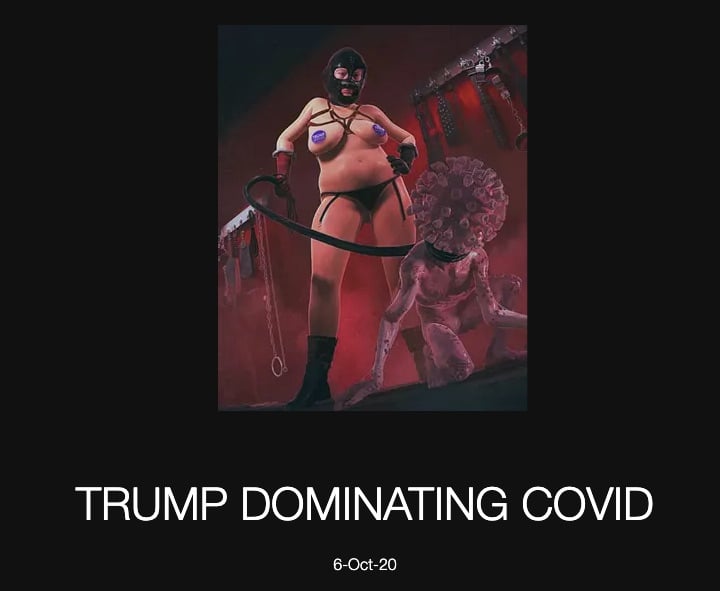
Screenshot of Beeple’s Trump Dominating Covid from October 6, 2020. Courtesy of the artist.
I’ve said that the Trump-is-a-Poopy-Head/Cheeto Mussolini genre of art that flourished in this time period is going to have the shelf life of Taco Bell leftovers. I don’t think a Beeple work like, say, Trump Dominating Covid from October 2020 is going to age that much more gracefully than Stephen Colbert’s “A Very Mueller Christmas” cartoon special or any one of Saturday Night Live’s many flaccid Resistance japes.
I mean, we’re talking commentary that at its sharpest is Beeple dreaming up an image of Lincoln spanking a nude Baby Trump.
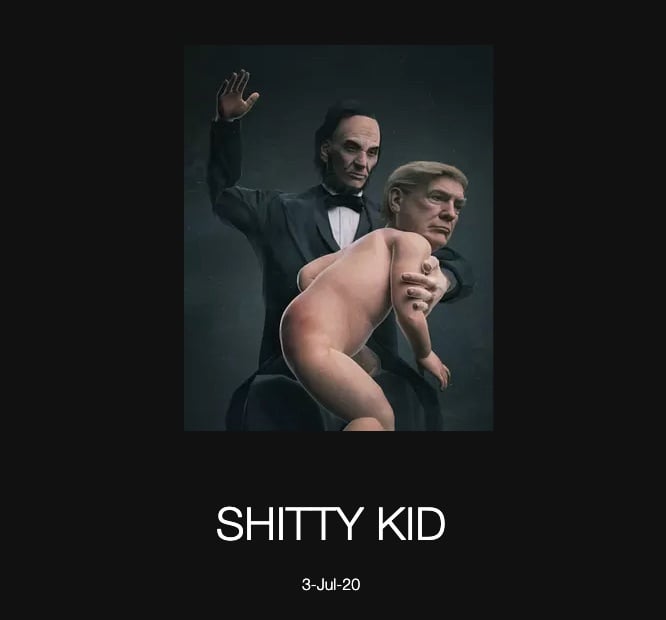
Screenshot of Beeple post. Courtesy the artist.
Long after her loss to Trump in 2016, Hillary Clinton inexplicably remains a dominating presence in Beeple’s recent satire, as with this August 2019 image of a mech-suited robo-Clinton feeding Trump via a tube from her crotch.
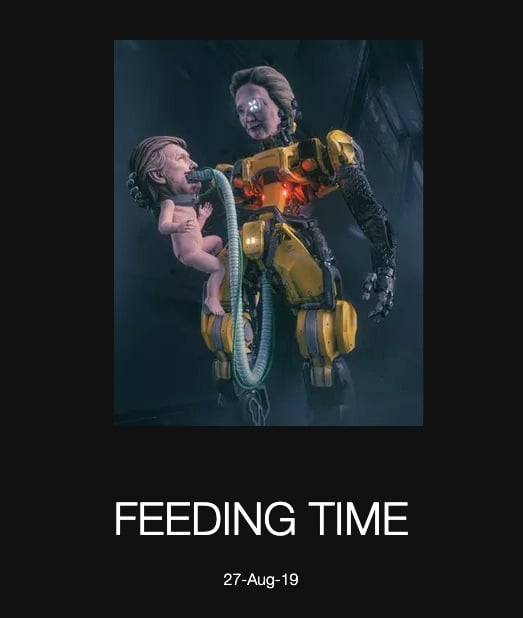
Screenshot of Beeple’s Feeding Time post from August 27, 2019, as posted to his website. Courtesy the artist.
Or this one from October 2019. As political satire, it’s not exactly Daumier. I’m not sure it’s even South Park.
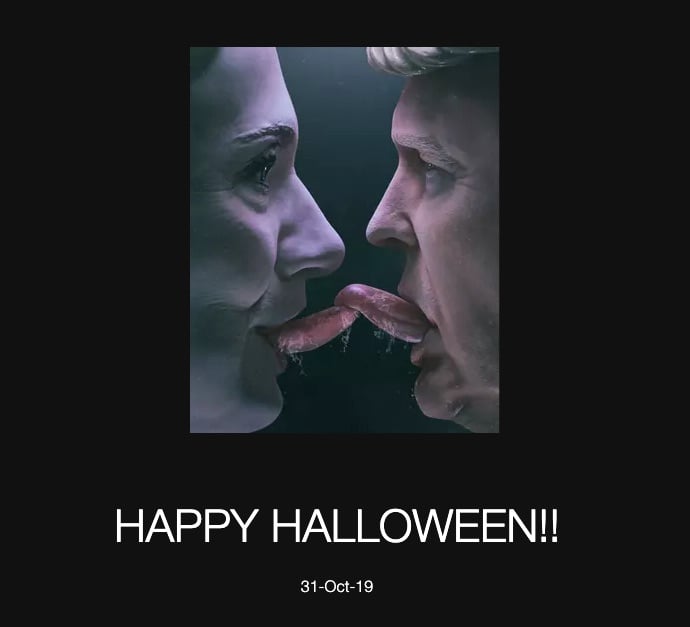
Screenshot of Beeple’s Happy Halloween post from October 31, 2020. Courtesy the artist.
In spirit, these “Everydays” mainly reflect the shrieking, Trump-era vitriol of cable news or Facebook comment wars, without any particular stable point of view. So, in addition to many, many gross-out Trumps, there’s also this image of Biden’s head awkwardly grafted to a female stripper’s body coming out of a cake.
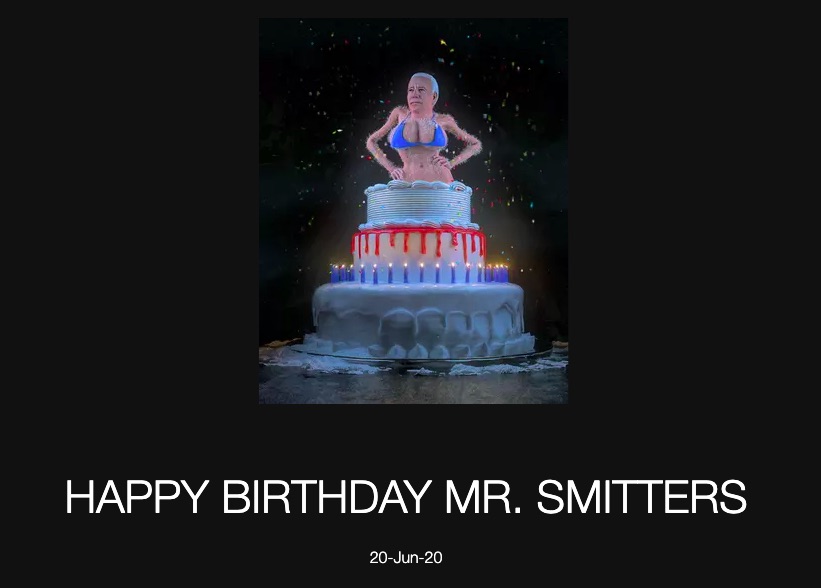
Screenshot of Beeple’s Happy Birthday Mr. Smitters from June 20, 2020, as posted to his website. Courtesy the artist.
Or this one of (a very poorly rendered) Bernie Sanders as a giant mother pig in a lab being milked.

Screenshot of Beeple’s Uncle Bernie’s Trillion Dollar Superteat from November 17, 2018, as posted to his website. Courtesy the artist.
When Beeple tries to be more earnest, as with this tribute to Black Lives Matter from last summer, the digital Gothic vibe that gives a drugged-out creepshow feel to his other works makes the results come off as ghoulish.

Screenshot of Beeple’s Endless Memorials from June 3, 2020, as posted to his website. Courtesy the artist.
But all this is just the most recent tranche of the Everydays. Eighty percent of the images recorded in the Christie’s opus predate the advent of this recent style.
Before the political satirist Beeple, there’s sci-fi illustrator Beeple. There’s lots of DeviantArt-esque dreamy landscapes with big robotic structures in them or small figures gazing at portals of light or worshipping spheres. This period lasts from 2015 to 2018.
Before sci-fi illustrator Beeple, there’s digital striver Beeple. This long period of abstract, semi-abstract, or awkwardly rendered images, where Beeple is just using his daily exercises to try out tools, lasts from 2011 to 2014. They have garish colors and are frenzied mishmashes of textures and patterns, with names like Synthetic Bubblegum Tittyfux.
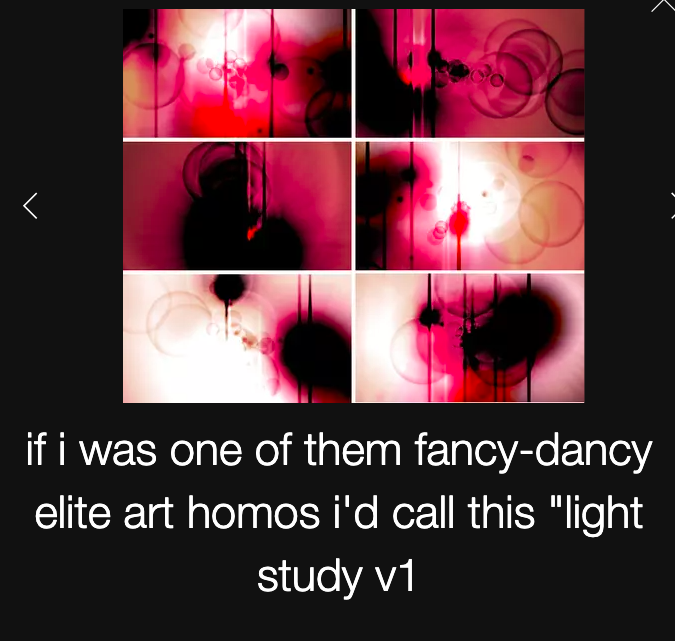
Screenshot of Beeple’s if I was one of them fancy-dancy elite art homos I’d call this ‘light study v1 from November 10, 2008. Courtesy the artist.
Sometimes, there’s a hint of the current-events angle that he would evolve toward, as with his mock-up of an invitation to the Royal Wedding of Kate and William in 2011, featuring the commentary “The Most Fairy Tale Part of the Wedding Night Will be When P. Willy Fucks Her Like a Common House Mule.”

Screenshot of Beeple’s $77 Million Later… post from April 11, 2011. Image courtesy the artist.
And then we arrive at the earliest period, from 2007 to 2011, when Winkelmann was in his late 20s and early 30s—before he even became a pixel-based artist, when he was just playing around with cartoons and uploading them to the web. (This period of work is clustered in the top left corner of the digital mosaic sold by Christie’s.)
It’s mildly interesting to see what Beeple’s early art influences were: punk drawer Zak Smith, cartoon painter Victor Castillo, and, interestingly, Martín Ramírez, the self-taught former janitor who made most of his work while institutionalized in a California mental hospital, and developed his own private, haunting lexicon of images. Beeple dedicates an entire series of “Everydays” to redoing themes from Ramírez, whom he refers to as a “tard.”
Beeple launched his drawing-a-day experiment in the build-up to the 2008 presidential elections. Whatever else has changed, the frankly misogynistic treatment of Hillary Clinton, at least, has been a consistent theme, as with this untitled “Everyday” from 2007.
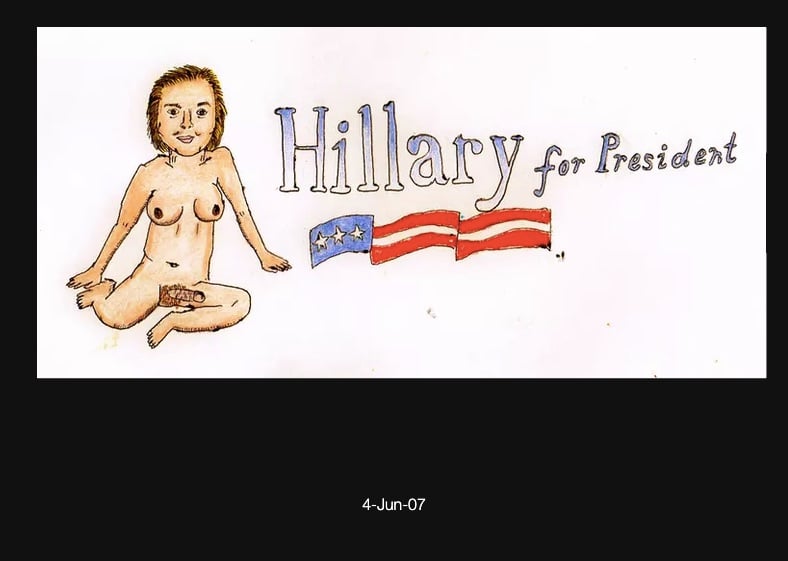
Screenshot of Beeple’s untitled “Everyday” from June 4, 2007. Courtesy the artist.
There’s also this picture of Hillary with a grill, put into the world during her doomed 2008 primary against Barack Obama.

Screenshot of Beeple’s senator clinton makes a last ditch effort to reach black voters from February 23, 2008. Courtesy the artist.
A lot of Beeple’s concerns in this period were the concerns of late-2000s hipster irony-bro culture: cartoons, porno, and the intersection between cartoons and porno. Thus, the “Everydays” have a lot of images like this.

Screenshot of Beeple’s robot girl discovers 20th century black dildos (and then it’s on like Donkey Kong), April 18, 2008. Courtesy the artist.
And many more like this.

Screenshot of Beeple’s Pussy from September 8, 2007. Courtesy the artist.
Or this.
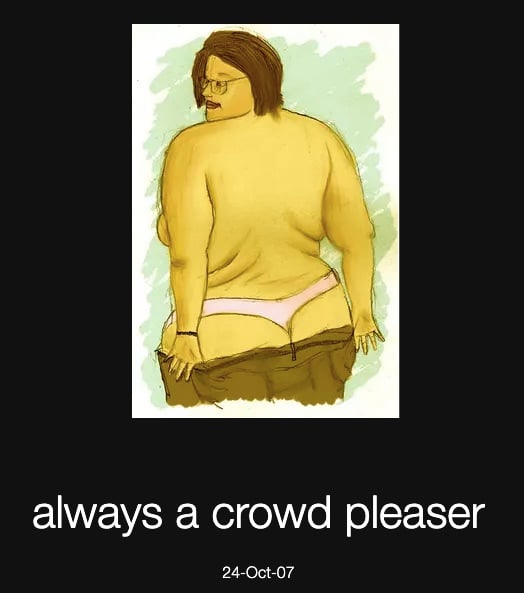
Screenshot of Beeple’s always a crowd pleaser October 24, 2007. Courtesy the artist.
Or this.
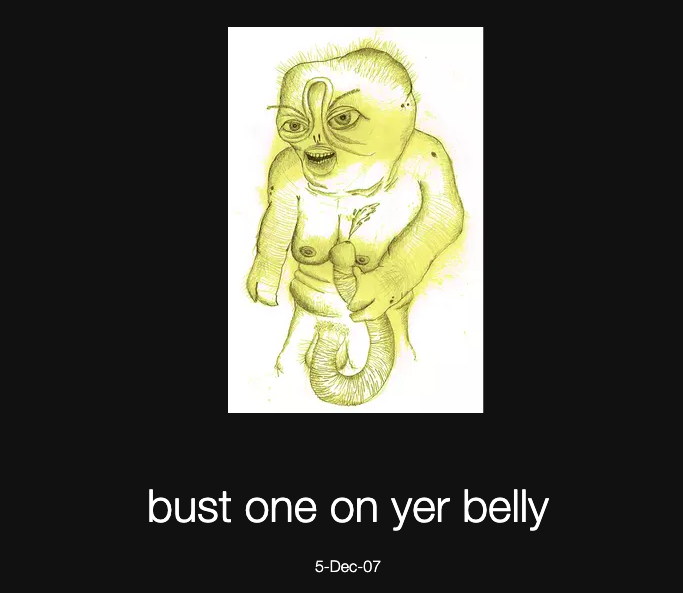
Screenshot of Beeple’s Bust One on Yer Belly from December 5, 2007. Courtesy the artist.
Plenty more are just cartoons with a directionless loutishness, like this drawing of a gender-swapped Captain Crunch rebranded as “Cap’n Bitch.” This very much does not read as something that was meant to be put in a museum and last forever.
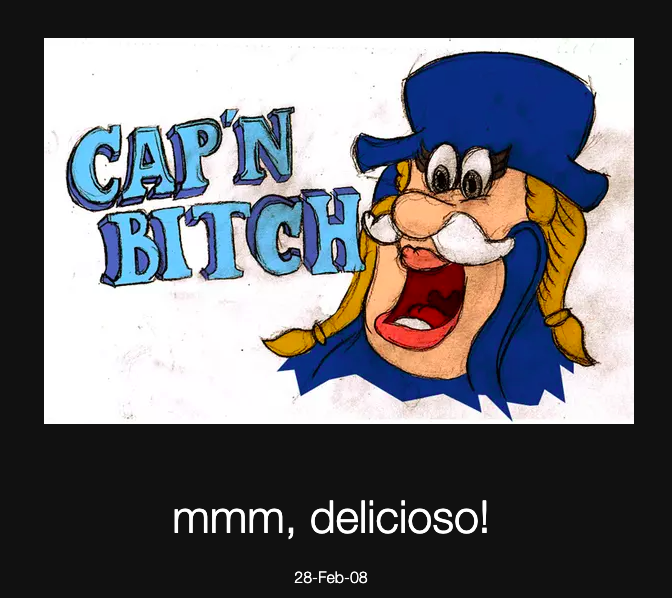
Screenshot of Beeple’s Mmm, Delicioso! from February 28, 2008. Courtesy the artist.
I’m not 100 percent sure what this “Everyday” starring the Dalai Lama comments upon. I will say that having the caption definitely affects the meaning.

Screenshot of Beeple’s The Dalai Lama should give some girl the peace symbol and then like totally finger fuck her from April 10, 2008. Courtesy the artist.
In case you were wondering if this immortal bit of commentary made it into the Christie’s lot, here it is, in the top edge.

Detail of Everydays: The First 5,000 Days showing the location of Beeple’s The Dalai Lama should give some girl the peace symbol and then like totally finger fuck her.
There are also works like this one. I mean, can you imagine Christie’s hanging an IRL version of this in their sales galleries?
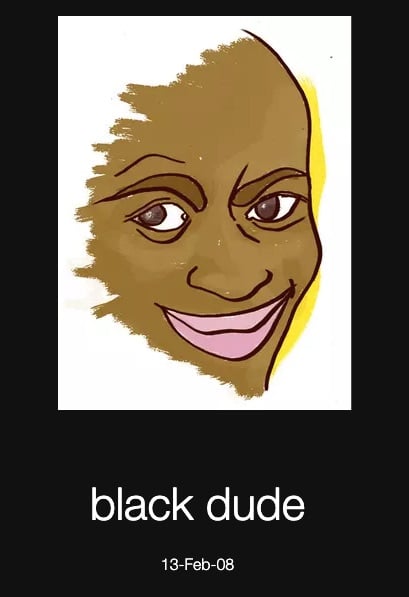
Screenshot of Beeple’s Black Dude from February 13, 2008. Courtesy the artist.
Here it is in the mosaic.
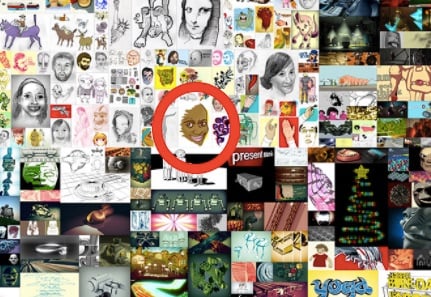
Detail of Everydays: The First 5,000 Days showing the location of Beeple’s Black Dude.
Along similar lines, there’s this.
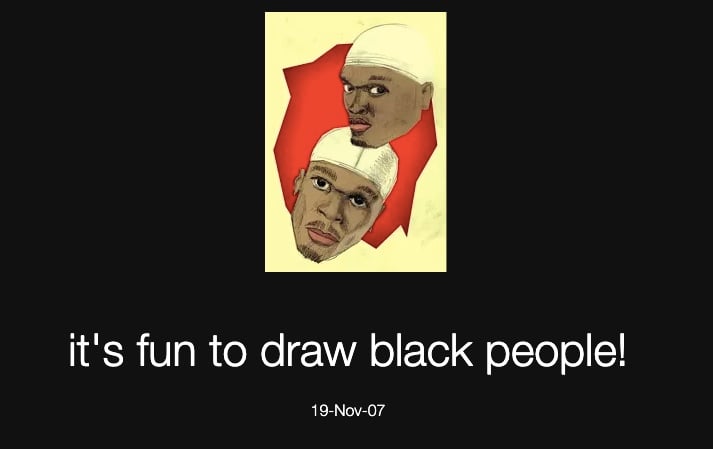
Screenshot of Beeple’s it’s fun to draw black people from November 19, 2007. Courtesy the artist.
Here’s where it is located, right next to a drawing of Babar the elephant with his penis out.
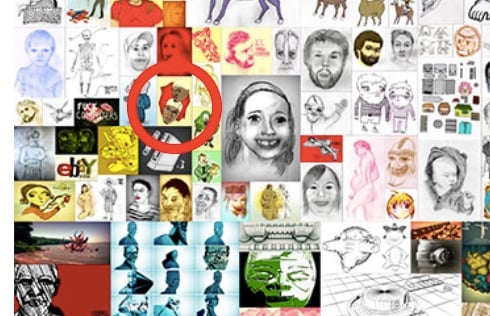
Detail of Everydays: The First 5,000 Days showing the location of Beeple’s it’s fun to draw black people.
Oh and then there’s this quaint Beeple “Everyday” from August 23, 2007.

Screenshot of Beeple’s a fat nerdy chinese kid and his imaginary friends from August 23, 2007. Courtesy the artist.
There it is, immortalized in the $69 million opus.
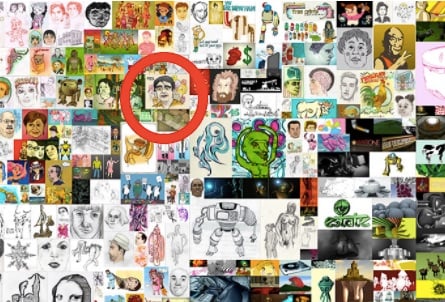
Detail of Everydays: The First 5,000 Days showing the location of Beeple’s a fat nerdy chinese kid and his imaginary friends.
When Twobadour, whose company bought the Beeple, talked to my colleague Eileen Kinsella, he said proudly that the plan was to create “a massive monument for this particular work of art which exists only in the virtual world.” In this online cathedral, web surfers from all over will be able to come to “experience the grandeur of this work.”
We’ve passed through a racial uprising and a reckoning with sexism, and the cultural project of the moment is… innovating new ways to worship decade-old, BroBible-level brain farts? During a time of immiseration, investors are competing to throw tens of millions of dollars… at this?
These are the questions that go through my head. But that’s probably just “fancy-dancy elite art homo” thinking, right?